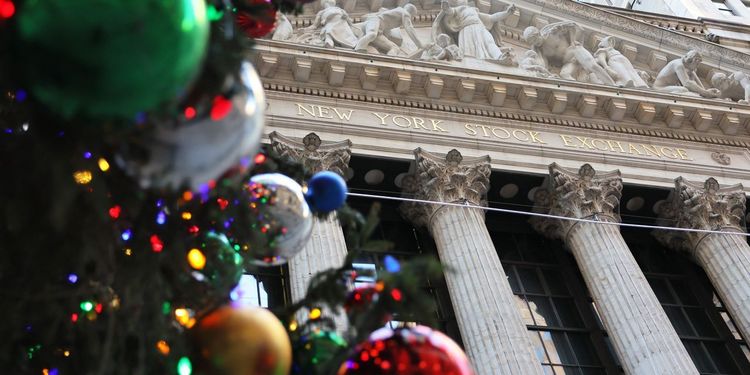
Is a 2023 stock-market rebound in store after 2022 selloff? What history says about back-to-back losing years.
History shows back-to-back losing years for the stocks are rare — but the size of the market’s drop in 2022 with no sign the Federal Reserve is ready to ride to the rescue means investors should beware, analysts warned.
With just a handful of trading days left in what is shaping up to be the worst year for the U.S. stock market in over a decade, the S&P 500 index is on track to close out the year down 19.8%.
That is the large-cap index’s first double-digit percentage loss since 2008, when it slid 36.6% during the global financial crisis, according to Dow Jones Market Data.
However, it is extremely rare for the S&P 500 SPX, -1.45% to post back-to-back down years. The S&P has fallen for two straight years less than 10% of the time from 1928 to 2021. In the year after a negative total annual return for the S&P, the index is up by 12.6% on average and is positive 17 out of 25 years, according to data compiled by DataTrek Research.
But the market’s performance after posting a double-digit percentage drop has been less straightforward.
“The S&P 500 has a much better win rate (79% vs 55%) and average performance (up 17.5% vs. 6.4%) in the 12 months following a down calendar year of less than 10% than one that does worse than that, and 2022 is shaping up to be in the latter camp,” said Jessica Rabe, co-founder of DataTrek Research, in a Tuesday note.
Rabe, however, noted that in the few instances when the S&P 500 has dropped consecutive calendar years, it’s been due to a major economic event, such as the Great Depression between 1929 and 1939, or a geopolitical shock, such as the World War II and the oil crisis in 1972, or both, in the case of the early 2000s when there was the bursting of the dot-com bubble, the Sept. 11, 2001, terror attacks and the subsequent U.S. invasion of Iraq.
She argued that there would likely need to be another major economic or geopolitical crisis for the S&P 500 to fall for a second consecutive year in 2023. However, help from the Federal Reserve in the form of lowering interest rates or a rise in federal government spending would be crucial for a bounce in the U.S. equities after a hard year.
“The Financial Crisis is a useful example to show that when times get truly difficult, fiscal and monetary policy stimulus can help the S&P rebound after a horrible year,” Rabe wrote.
The S&P 500 booked an annual loss of over 36% in 2008 after Lehman Brothers went bankrupt under the weight of $619 billion in debt due to investments in subprime mortgages. The index was up 25.9% in the following year after the Federal Open Market Committee decided to increase the size of the Fed’s balance sheet by purchasing additional government-sponsored agency mortgage-backed securities, in response to the severity of the economic contraction.
However, Wall Street strategists warned stock-market investors that they should not expect any form of “Fed put” next year.
Investors have talked of a figurative Fed put since at least the October 1987 stock-market crash prompted the Alan Greenspan-led central bank to lower interest rates. An actual put option is a financial derivative that gives the holder the right but not the obligation to sell the underlying asset at a set level, known as the strike price, serving as an insurance policy against a market decline.
Victoria Fernandez, chief market strategist at Crossmark Global Investments, thinks the Fed is going to let the market work through the “shallow recession” in 2023 and not immediately jump in and cut rates.
“Historically we assumed and knew that we would have a ‘Fed put’, that immediately Fed steps in and handles it for us. But what Powell is trying to make markets understand is, hey, we are not going to be doing this,” Fernandez told MarketWatch on Tuesday.
“They’re just willy-nilly trying to drive us over the cliff,” she added.
“That’s why U.S. equities are so volatile just now, as no one knows when the Fed will pivot to being more accommodative. Chair Powell is solely focused on bringing down inflation to the Fed’s 2% target and he has the latitude to do so given the strength of the U.S. labor market,” said Rabe at DataTrek.
U.S. stocks ended sharply lower on Thursday after Wednesday’s rally. The Dow Jones Industrial Average DJIA, -1.05% dropped 1.1%, on pace to book an annual loss of 9.1%. The Nasdaq Composite COMP, -2.18% shed 2.2%, having decreased by 33% year-to-date. The S&P 500 was down 56 points, or 1.5%, ending at 3,822.
See: New research claims the bear market won’t be over until the VIX says so.
David Wagner, portfolio manager for Aptus Capital Advisors in Cincinnati, told MarketWatch that he expects the stock market to experience less pain and less price volatility next year, but that doesn’t mean investors will see positive market returns.
“We believe that a policy error has already been committed by the Fed. The real and long-lasting policy error would be if inflation were to become unanchored, thus the emphasis on the market focusing on price stability, specifically wage inflation, in the near-term,” Wagner said.
“History shows us that markets are a sprint lower and a marathon higher. With the potential for slowing global growth and a less accommodative Fed, this marathon may include more hills than plains, which could create constant volatility in the market,” he said.
Source : [Is a 2023 stock-market rebound in store after 2022 selloff? What history says about back-to-back losing years.](www.marketwatch.com/story/is-a-2023-stock-market-rebound-in-store-after-2022-selloff-what-history-says-about-back-to-back-losing-years-11671650574?mod=newsviewer_click) undefined - December 22, 2022